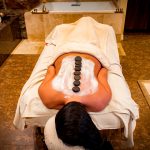Back pain treatment may involve medication or, in some cases, surgery. But with Natural Remedies for Back Pain Relief for back pain, such as exercise, spinal manipulation, and massage, are among the top recommendations for both acute and chronic cases. While some are supported by research and included in clinical practice guidelines, other natural remedies for back pain have more anecdotal than scientific evidence to back them.
If you’re interested in using a natural remedy for back pain relief, you might consider one of the following popular options. Some of them may offer relief for mild to moderate discomfort, particularly when part of a comprehensive treatment plan.
1. Keep Active
In times past, bed rest was often suggested for treating acute back pain. Today, your doctor will likely advise you to maintain your usual activities and avoid extended bed rest. In fact, the first-line treatment for both acute and chronic low back pain is to remain active.
Walking and avoiding sitting for long periods may help. Even if you find it painful, try to walk for a few minutes each hour. Gentle stretches before your normal activities may also be beneficial.
Be sure to discuss any activities you normally do that might result in further back strain, such as heavy lifting or twisting, with your doctor. They may be able to suggest modifications that are back-friendly. Your doctor may also recommend stretching and exercises you can do at home.
2. Exercise Therapy
If you have persistent back pain for over 12 weeks, a graded activity or exercise program that focuses on improving function and preventing further disability is considered to be first-line therapy.
The program should be individualized to meet your needs and abilities, and no single program has been shown to be better than another. A physical therapist can recommend exercises and activities, which can include some that come from Eastern traditions, such as yoga or tai chi.
Yoga
Yoga is a form of exercise that creates balance in the body through various poses that develop flexibility and strength. There’s some evidence that taking up a yoga practice may help relieve chronic back pain.
Tai Chi
Tai chi is an ancient martial art that involves slow, graceful movements and incorporates meditation and deep breathing. Although research on the use of tai chi in the treatment of back pain is somewhat limited, there’s evidence that practicing tai chi may help alleviate back pain to some degree.
3. Alexander Technique
The Alexander Technique is a type of therapy that teaches people to improve their posture and eliminate bad habits such as slouching, which can lead to pain, muscle tension, and decreased mobility. A 2012 review found strong scientific support for the effectiveness of the Alexander Technique lessons in the treatment of chronic low back pain.6
You can learn the Alexander Technique in private sessions or group classes. A typical session lasts about 45 minutes. During that time, the instructor notes the way you carry yourself and coaches you with verbal instruction and gentle touch.
You can find an instructor by using the searchable database on the American Society for the Alexander Technique’s website.
4. Acupuncture
Studies have supported the use of acupuncture for chronic low back pain, and the clinical practice guidelines from the American College of Physicians rate the evidence for this as having moderate quality.7 It may be considered as a second-line or adjunctive treatment for both acute and chronic low back pain.
According to traditional Chinese medicine (TCM), pain results from blocked energy along the meridians of the body, which are unblocked when acupuncture needles are inserted along these invisible pathways. Some theorize that acupuncture may release natural pain-relieving opioids, send signals to the sympathetic nervous system, and release neurochemicals and hormones.
If you want to try acupuncture for your chronic pain, plan on going one to three times a week for several weeks initially. Acupuncture may be tax-deductible as a medical expense and some insurance plans pay for acupuncture.
5. Spinal Manipulation
Doctors of chiropractic use chiropractic spinal manipulation to restore joint mobility. They manually apply controlled force to joints that have become restricted by muscle injury, strain, inflammation, and pain. This manipulation is believed to relieve pain, ease muscle tightness, and encourage healing.
Spinal manipulation is considered a second-line or adjunctive treatment for both acute and chronic low back pain.2
6. Massage Therapy
The research as to whether or not massage is an effective treatment for low back pain is of low to very low quality; it may provide only short-term relief. Whether or not research can prove that massage therapy helps, many people report that it relaxes them and eases their chronic pain. It may also alleviate anxiety and depression associated with chronic pain.
Massage therapy can be a second-line or adjunctive treatment for both acute and chronic low back pain.
7. Mindfulness-Based Stress Reduction
Mindfulness-based stress reduction (MBSR) programs include a combination of meditation, hatha yoga, and body scan exercises. These programs have been developed for those experiencing chronic pain.
Reviews of studies have found only slight, short-term benefits in reducing pain and improving function for those with chronic low back pain.9 The yoga component appears to be necessary in order to get functional improvement.
8. Cognitive-Behavioral Therapy
For those with chronic low back pain, there is some evidence of cognitive-behavioral therapy (CBT) being useful.7 This form of psychological therapy aims to reduce negative and catastrophic thoughts, which often result in more complaints of pain. It helps the person appraise their pain realistically and cope with it better.
9. Topical Capsaicin
Capsaicin is the active ingredient in chili peppers. When applied to the skin, capsaicin has been found to deplete a neurochemical that transmits pain, causing an analgesic effect.
Capsaicin cream, also called capsicum cream, is available over the counter. A typical dosage is 0.025% capsaicin cream applied four times a day.
High-dose capsaicin patches are available by prescription for treating neuropathic pain. Patches with an 8% dosage have been found to be effective for low back neuropathic pain.10
9. Herbal Medications
No herbal medication has been included in clinical practice guidelines for low back pain, but a variety of herbs have been studied to see whether they are safe and effective.
A Cochrane review of studies found that Capsicum frutescens (cayenne) reduced pain more than placebo.11 This review also found moderate evidence that Harpagophytum procumbens (devil’s claw), Salix alba (white willow bark), Symphytum officinale L. (comfrey), Solidago chilensis (Brazilian arnica), and lavender essential oil might reduce pain more than placebo.
When using an herbal supplement or topical preparation, be sure to discuss it with your healthcare provider. This can help prevent negative interactions with your other medications and determine whether it is appropriate for you based on your medical history.
10. Balneotherapy
One of the oldest therapies for pain relief, balneotherapy is a form of hydrotherapy that involves bathing in mineral water or warm water. This form of therapy remains popular in Europe for the treatment of musculoskeletal pain.
Although it has not appeared in U.S. clinical guidelines, it is supported by some research studies. A 2019 review of studies found it may provide pain relief and improve function.12 Of note, people with heart conditions should not use balneotherapy unless under the supervision of their primary care provider.
Dead Sea salts and other sulfur-containing bath salts can be found in spas, health food stores, and online.
A Word From Verywell
If you’re considering using alternative medicine for back pain, talk with your doctor first. It’s important to note that self-treating with alternative medicine and avoiding or delaying standard care may be harmful to your health.









